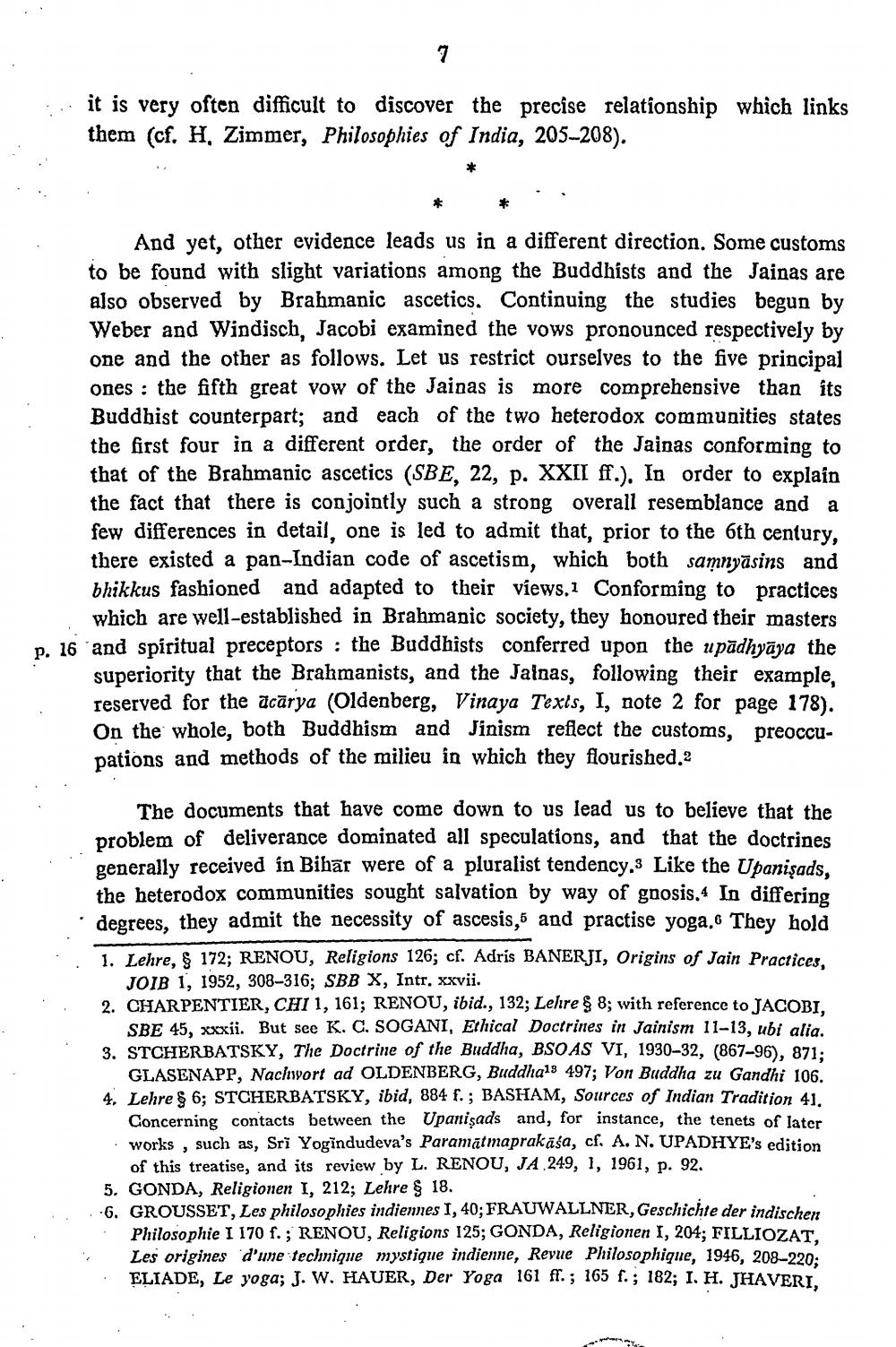________________
... it is very often difficult to discover the precise relationship which links
them (cf. H. Zimmer, Philosophies of India, 205–208).
And yet, other evidence leads us in a different direction. Some customs to be found with slight variations among the Buddhists and the Jainas are also observed by Brahmanic ascetics. Continuing the studies begun by Weber and Windisch, Jacobi examined the vows pronounced respectively by one and the other as follows. Let us restrict ourselves to the five principal ones : the fifth great vow of the Jainas is more comprehensive than its Buddhist counterpart; and each of the two heterodox communities states the first four in a different order, the order of the Jainas conforming to that of the Brahmanic ascetics (SBE, 22, p. XXII ff.). In order to explain the fact that there is conjointly such a strong overall resemblance and a few differences in detail, one is led to admit that, prior to the 6th century, there existed a pan-Indian code of ascetism, which both samnyāsins and bhikkus fashioned and adapted to their views.1 Conforming to practices
which are well-established in Brahmanic society, they honoured their masters . 16 and spiritual preceptors : the Buddhists conferred upon the upādhyāya the
superiority that the Brahmanists, and the Jainas, following their example, reserved for the acārya (Oldenberg, Vinaya Texts, I, note 2 for page 178). On the whole, both Buddhism and Jinism reflect the customs, preoccupations and methods of the milieu in which they flourished.2
... Probi.
The documents that have come down to us lead us to believe that the problem of deliverance dominated all speculations, and that the doctrines generally received in Bihār were of a pluralist tendency,3 Like the Upanisads.
the heterodox communities sought salvation by way of gnosis. In differing • degrees. they admit the necessity of ascesis, and practise yoga. They hold
1. Lehre, § 172; RENOU, Religions 126; cf. Adris BANERJI, Origins of Jain Practices.
JOIB 1, 1952, 308-316; SBB X, Intr. xxvii. 2. CHARPENTIER, CHI 1, 161; RENOU, ibid., 132; Lehre & 8; with reference to JACOBI.
SBE 45, xxxii. But see K. C. SOGANI, Ethical Doctrines in Jainism 11-13, ubi alia. 3. STCHERBATSKY, The Doctrine of the Buddha, BSOAS VI, 1930-32, (867-96). 871.
GLASENAPP, Nachwort ad OLDENBERG, Buddhals 497; Von Buddha zu Gandhi 106. 4. Lehre $ 6; STCHERBATSKY, ibid, 884 f. ; BASHAM, Sources of Indian Tradition 41.
Concerning contacts between the Upanişads and, for instance, the tenets of later • works, such as, Sri Yogindudeva's Paramātmaprakāśa, cf. A. N. UPADHYE's edition
of this treatise, and its review by L. RENOU, JA 249, I, 1961, p. 92. 5. GONDA, Religionen I, 212; Lehre & 18. 6. GROUSSET, Les philosophies indiennes I, 40; FRAUWALLNER, Geschichte der indischen
Philosophie I 170 f.; RENOU, Religions 125; GONDA, Religionen I, 204; FILLIOZAT. Les origines d'une technique mystique indienne, Revue Philosophique, 1946, 208-220 ELIADE, Le yoga; J. W. HAUER, Der Yoga 161 ff. ; 165 f. ; 182; I. H. JHAVERI.




